Table of contents
- Comparison test: 10 supersport bikes Time fuse
- Time fuse
- Ducati 1098 R – Red Eminence
- KTM 1190 RC8 – Calimero
- Suzuki GSX-R 600 – Mister Nice Guy
- BMW HP2 Sport
- Yamaha YZF-R6 – The uncompromising one
- Suzuki GSX-R 750
- Honda Fireblade – The dynamic one
- Yamaha YZF-R1
- Suzuki GSX-R 1000 – The gentle giant
- Kawasaki ZX-10R – The Rebel One
- Conclusion
- Measurements
- Technical data and setup
- valuation
- Dunlop GP Racer Slick
- Polo tire warmers
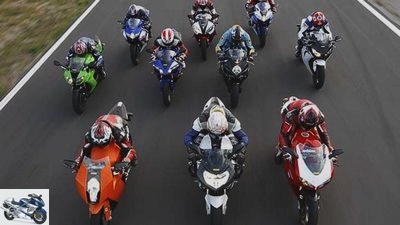
K
motorcycles
Comparison test: 10 supersport bikes
Comparison test: 10 supersport bikes
Time fuse
Content of
Verbal infight in the editorial office: “The RC8 completely flattens the Japanese!” ?? “Nonsense, the Fireblade drives so brilliantly, it burns everything down.” ?? “Oh well, the 1098R is the benchmark.” ?? “Don’t forget the HP2!” ?? “Let’s go out?”
Sebastian Lang, Robert Gluck, Volkmar Jacob, Uwe Seitz
05/15/2008
Time fuse
Said and done. In addition to the 4 super athletes mentioned, the crew stows another 6 bikes in a truck, packs standard tires and timekeeping equipment and sets off with the ex-IDM supersport champion Arne Tode as a time hunter to Montpellier in the south of France. The demanding Dunlop test track awaits the team there: the 3050 meter long circuit has tricky handling sections, and at the braking point on the approx. 530 meter long start / finish straight, the most powerful bikes have a speed of 240 km / h. A nasty chicane at the end of it can withstand a maximum of 62 km / h. The mountain-and-valley route has a mostly flat surface.
Compete for the big athlete showdown: BMW HP2 Sport, Ducati 1098R, Honda CBR 1000 RR Fireblade, Kawasaki Ninja ZX-10R, KTM 1190 RC8, Suzuki GSX-R 750 and 1000, as well as Yamaha’s YZF-R1. This is joined by the six hundred from Suzuki and Yamaha. While they are already having a hot fight with their direct competition this issue, they are brand new and it will be interesting to see how they hold up against bigger bikes. For the technical data of the 600 series, we refer to the 600 series comparison, which saves space. The test field is between 599 and 1198 cm³ and between a good 120 and over 180 hp. Because it is very wide, this time there is a maximum of ten stars per discipline. In addition, the lap time is included in the result. Curtain up!
Ducati 1098 R – Red Eminence
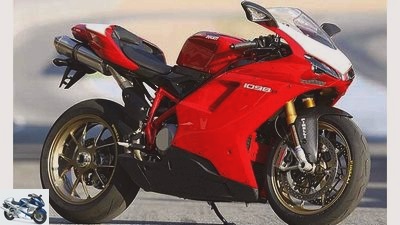
K
The racy Italian Ducati 1098R achieved a best time of 1: 25.04 minutes.
The 1098R has the charisma of a representative of a higher caste. This is probably due to the fact that it is out of reach for normal people, that Troy Bayliss serves as the base of operations in the Superbike World Championship and that it is the first motorcycle to have traction control. PSlers, fearless and disrespectful, don’t let themselves be dazzled: For us, the 1098R is just very strong, light and excellently prepared for life in the ring. In addition to the DTC (Ducati Traction Control), it offers a very crisp power-to-weight ratio that even a Fireblade with a racing exhaust cannot quite match. 183 HP at 190.5 kg, measured with open racing pots, which are required to activate the DTC including the racing control unit, is a lot of wood. However, when they are installed, the license to play on the road expires, which is why the heartwarming, booming Ducati in this test is on the one hand your eminence, on the other hand the fact that all the electronic bells and whistles not only bring you fame and honor is a sad and hopefully not regularly told story :
As a reference bike, the Duc should burn everything in Mireval, especially because of its traction control. In the end, she crossed the finish line with just two and a half tenths of a second before the Fireblade. On the day of the lap times the electronics went on strike, the DTC got out, the Duc ran in the emergency program. A busy Ducati dealer then got it working again without DTC. However, with the DTC, the otherwise so good responsiveness of the power twin had also been adopted. What remained was a well-balanced Ducati 1098, which delighted the driver’s heart with unbelievable pressure, left speechless, overwhelmed by its sheer power. If you hide the price tag, you can enjoy the stable chassis, the feedback of the suspension elements and the grip of the tires without remorse. Once warmed up, the ride on the red cannonball becomes something like a meditative act that unites horse and rider. And how good even a wound 1098R is is proven by the lap time.
KTM 1190 RC8 – Calimero
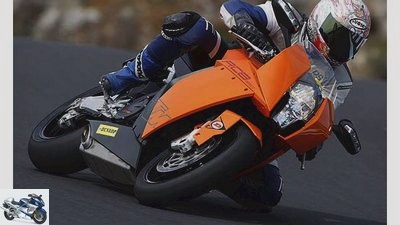
K
Washed in the water: The KTM 1190 RC8 hands out like a big one, even though it wasn’t long ago it was hatched.
the KTM somehow reminiscent of Calimero, that cheeky chick with the eggshell on its head. Shortly after hatching, Calimero was already full of water and was able to dish out like a big one. The RC8 can do that too: barely presented, PS pulls one of the first test copies into a major burner competition. Somehow surprising, but also somehow not that surprising result. Surprising, because the RC8 burns the third fastest time on the asphalt on the Dunlop slicks. Less surprising, because we at KTM know that they only come out of cover with test material if the package works properly.
Despite this brilliant lap time, there is still a lot to do on the RC8. The test motorcycle was not at its best when it came to the engine; the hard throttle response hit the line more than once in a narrow left uphill passage. Precarious: These load peaks almost forced the already light front wheel to fold in, didn’t it? TOI Toi Toi, ?? but it didn’t happen. The very linear power delivery, on the other hand, was right, but the stubborn, unwilling transmission inhibited quick gear changes and occasionally engaged an intermediate idle.
The chassis and suspension qualities of the KTM racer are at a high level. The fork is quite soft in relation to the shock absorber, but the balance is good. Despite prolonged twists and turns on the various adjustment options of the KTM, it was not possible to stop the slight running-wide tendency, i.e. understeer from the apex. Again, the ergonomics of the RC8 are great. If you want to be comfortable on country roads, you can fix the rear at the top and the catches at the bottom (four screws each on the catches and the rear). Whoever goes on fire must at least put the notches up. However, this still does not prevent them from making contact with the asphalt in an inclined position. The basic qualities of the RC8 are undisputed, but it needs a bit of maturity. And it will definitely come.
Suzuki GSX-R 600 – Mister Nice Guy
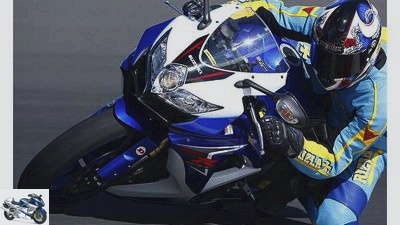
K
Small displacement, blunt sword: the Suzuki GSX-R 600 fights its way through the ranks of the new super sports cars.
The Suzuki finds its big destination GSX-R 600 not on the racetrack. It has too much suitability for everyday use, which is particularly evident in the seating position ?? the adjustable footpegs do not change that much, their dimensions and the soft dampers. In the battle of the new super athletes in 2008, the GSX-R 600 is not only fighting with a blunt sword because of its small displacement. Nevertheless, it is not out of place on the slopes. She is the Mr. Nice Guy, with whom the less experienced hobby racer can get along well.
The Suzi takes on the gas cleanly, gives her power to the rear wheel in harmony and lets herself be guided through the meandering without major flaws. In curve combinations, even the R6 iron can cut itself off a bit from the GSX-R, so it can be thrown from left to right or vice versa. Speaking of which we are comparing the two 600s: Put the brakes on on the one here Yamaha acted, so cleanly worked the Suzuki. Again a plus point for the young racer, because the delay is very reliable, progressive, precisely adjustable, but without the wild bite that could quickly turn a shock brake into a shoulder throw. In addition, the Suzuki has a great anti-hopping clutch and the electronically controlled steering damper. The attack can thus be perfected, but the GSX-R has to leave the killing to other hunters.
BMW HP2 Sport
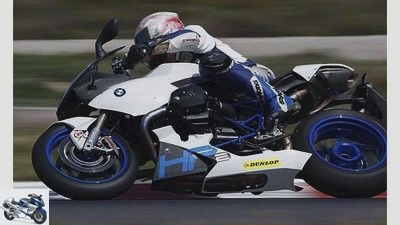
K
The dashboard of the BMW HP2 Sport comes from 2D and can probably store more data than the federal library.
Nobody can say exactly how often the famous word attributed to Winston Churchill has been used to describe indulgent motorcycles that are not talented in sport. The brands BMW and Harley-Davidson can certainly be found in the top 3 of the “No Sports” hit list.
However, this slogan is completely inaccurate with the HP series of the white-blue, especially the HP2 Sport. No boxer BMW before has been prepared with so much passion, brainpower and dedication for life in the Kringel as this one. The details make one overlook the eyes: adjustable handlebar stubs, multiple adjustable footrests, automatic gearshift, the Superduper display with four billion functions, the carbon dress, the light rims and the Ohlins shock absorbers ?? one in front, one in the back. Everything, everything is there, seems infinitely valuable and enthusiastic. Even the sound of the flat twin, which is otherwise more reminiscent of a farting deer, has blossomed into the celebrating roar of a ruthless moose.
But with so much attention, will a boxer BMW become a race bike? Will the three H manage to form a time iron out of her? Definitely “yes and no”: The HP2 Sport is, measured by its base, a very fast motorcycle. On a special line she even drives extremely fast under a pilot who is shot at her; but the normal can fail because of their nature. Basically, the sport has everything to it and what a racer needs, but with its innermost genes it gets in the way: The Telelever does not allow the communication with the front wheel that is familiar from a telescopic fork, and the valve covers always drag on the ground, when it gets interesting. It takes some time to realize the power of the Telelever on the brakes and to convert this advantage into lap times. The engine shows how pointed the HP2 Sport is. He has a race-ready speed range of at least 2000 tours, between 7000 and 9000 rpm namely ?? and it’s not a 125 two-stroke, but a 1200 four-stroke twin. Let’s close with another quote: “We love it” ?? not the burger joint, but the HP2 Sport.
Yamaha YZF-R6 – The uncompromising one
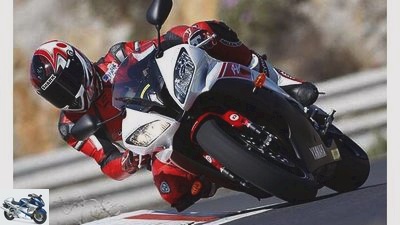
K
The uncompromising beauty can be seen with her best time of 1: 27.49 minutes.
She sweats, bleeds, and pees racing; on the racetrack it is a force. It even hits the 1000s on winding stretches without long straights. We’re talking about the Yamaha R6. Have you ever sat on it? Then there is no mistaking it. From high up on a perfectly shaped bench, the arms fall down to the stumps, the snorting begins under the helmet? Attack! The attenuation allows the sharpest lines ?? if the tire is right. Lately the R6 has also come on the Bridgestone BT-016 in specification F, and that was not the yellow of the egg, running-wide the result. If you held against it, you risked a nasty sliding front wheel.
But we put the R6 on Dunlop slicks and lo and behold, old virtues were introduced. It’s amazing how the R6 waves, precisely steers and always informs the driver what the rear wheel and the front are doing. So the R6 was able to hold its own very well in the test field, and no one is surprised. It could have gone even better if the brakes had also been blessed with racing genes. But these stoppers were unusually weak. Fading set in and there was no will to bite: she simply did not react to increased hand pressure. It’s a shame, because with this superb slipper clutch and the uncompromising braking stability, even better times would have been possible. And why this guillotine has to get by without a steering damper is probably only known to the Yamaha controller.
Suzuki GSX-R 750
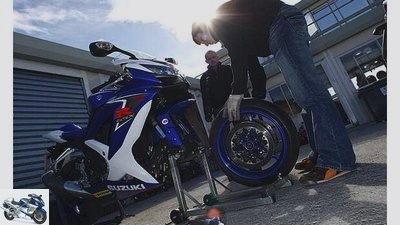
K
Luckily the sun is shining, otherwise the slicks would have to go down again.
World Cup-compliant cubic capacity can actually bypass the hobby racer, it has to be drivable. What particularly distinguishes the GSX-R 750: Compared to the four-cylinder 600s, it has no performance window, but a performance barn door, and compared to the 1000s, it has accident insurance built into the throttle. While the 600 sister wants to be moved precisely in a narrow speed range and requires a lot of gear changes in order to really make meters, the three-quarter Gixxer snorts past the 600 in a higher gear at the corner exit.
At the same time, it is easy on the nerves of your rider compared to the liter rockets, especially noticeable from the super-fast right out onto the short straight. “Tap on!”, it says here. A blade racer needs either nerves like wire ropes or mental derangement for the same hand movement. The credo: simple driving makes you fast. The 750 works a little rougher than the 600 engine, accelerates more roughly, but can be dosed nicely. The GSX-R 750 is in the same frame as the 600, but the 750 is much better. With its rich torque and power plus, it doesn’t seem so oversized. Nevertheless, it basically has the same weaknesses: the seat is slippery, the driver moves a lot and cannot find a central workstation. In general, the seating position is more like a country road than a racetrack.
But the handling corresponds to the positive impression of the engine? easy going. Moving in alternating curves is a highlight. The Suzuki scurries precisely in an inclined position. At the end of the bend it goes a little further, but once folded down, it lies well in the bend. In addition, our chassis changes have brought a significant increase in braking stability. The soft standard setup brings a lot of movement into the motorcycle and therefore calls for toughness. But despite the good slipper clutch, the Gixxer is still prancing a bit. There is also an excellent decelerating and adjustable brake. “A sharp all-rounder”, says Zeitenbolzer Tode in conclusion. We think so too.
Honda Fireblade – The dynamic one
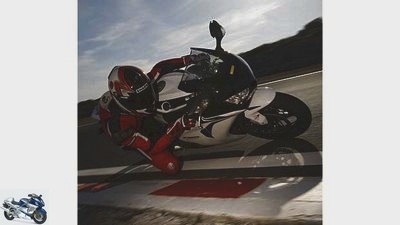
K
Not quite as racist: the Fireblade in the cockpit offers gearshift light and clock; Lap timer and gear indicator: none.
Relaxed, sporty seating position, steady, bearish performance, uncomplicated handling: Honda’s latest super sports car shines with features that ensure a fat grin under the helmet both when cruising on country roads and when burning times on the racetrack. Even at moderate speeds, the engine kicks in with such force that it sends shivers down the pilot’s spine. From 6000 rpm there is enough pressure in second gear to let the front of the Honda rise towards the sun, calmed by the electronically controlled steering damper.
An impressive performance, which is not that fast, but a lot of fun. The Honda also shows its dynamic side when braking. A gentle pull on the brake lever is enough and the pads in the four-piston calipers pounce on the discs like a pack of groupies on Robbie Williams. However, after a few fast laps the brakes wear off and severe fading sets in; other brake fluid could possibly help. On the other hand, the poor braking stability of the Honda is not so easy to fix. Depending on the brake pressure, the stub rear tends to either break away or lift off. The great anti-hopping clutch effectively prevents rear wheel stamping and allows superb braking drifts, but the Fireblade remains very restless when the brakes are applied.
Otherwise, that cannot be said of the chassis. Handling, chassis and suspension elements show their best side. Times hunter Arne Tode agrees with the testers and speaks of a milestone: With minimal effort, the blade folds into a deep incline, draws a clean, narrow line and sucks along the apex of the inner curb. In this way, the 1000 series cuts arcs through the curves that even the lively 600 series have trouble with, and completely stress-free: the finely responsive undercarriage informs the pilot about the state of grip and the condition of the road surface at any time. In the end, she is just 0.24 seconds short of the best lap time of the Ducati 1098R. But the Honda is much more comfortable? and over 20,000 euros cheaper.
Yamaha YZF-R1
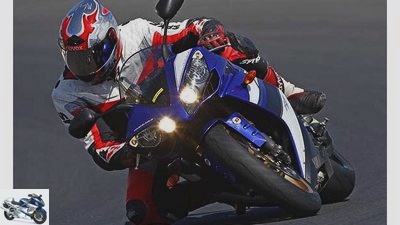
K
The swing arm of the Yamaha YZF-R1 is over 600 millimeters long. Therefore, the chain tensile forces exert less influence on the geometry, which creates calm.
It is always a special experience when the big block of the Yamaha R1 tears, has worked its way through the slight slack at around 7000 rpm and from this mark on it starts firing like a space shuttle drilling into the sky. Despite electronically controlled throttle valves and despite the variable intake manifold lengths that have been working in the Yam since 2007, their performance is still somewhat inhomogeneous.
Whatever is attractive has its risks. For example, when you power out of curves, when the punch starts at the right angle when you are in a sloping position when you need to pull the throttle with feeling. There is no doubt that the pilot has to adjust to the power output on the hunt after fast laps. Otherwise, the drive convinces with acceptable load change responses, cultivated engine running and cleanly shiftable gearbox. In addition, the R1 growls the coolest sound from its underseat exhaust that has ever come from a Japanese Euro 3,000.
Another highlight is the chassis of the Yam. The spring elements glide super-sensitively over the few asphalt faults on the route and have sufficient damping reserves, the handling was sensationally light-footed. It’s overwhelming how easy the big Yamaha tears through a tricky and slow uphill change curve and how confidently it masters the nasty right-left-right chicane after start / finish. The blue one also masters turning on the brakes perfectly, and it impresses with first-class precision. Should the pilot still have to correct the line, the Yamaha can be directed nicely.
The ergonomics of the R1 are also beyond any doubt. The seating position is sporty, but not extreme; the triangle consisting of seat, footrests and handlebars ideally positions drivers of all stature, the driver always has the racer perfectly under control. The stoppers are also enthusiastic: A stable pressure point, high transparency, good controllability and excellent braking performance characterize the system. Despite these wonderful properties, the R1 burns “only” the fourth fastest time in the asphalt. The reason for this lies mainly in the aforementioned power delivery ?? Other bikes power out of the corners more vehemently and get those tenths of a second that ultimately make the difference.
Suzuki GSX-R 1000 – The gentle giant
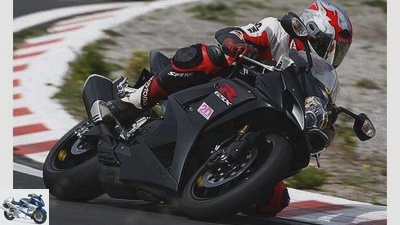
K
The Suzuki GSX-R 1000 proves to be user-friendly, honest and straightforward.
It happened on the second day before the lap time milling. A colleague involuntarily tested the sliding properties of metal, rubber and plastic on asphalt at almost 160 km / h. The tester was lucky in the misfortune, the Suzuki GSX-R 1000 however, it is badly damaged and impossible to continue. Repairing or getting a replacement machine was not necessary due to lack of time.
The lack of lap time is the reason why PS the Kilo-Gixxer only in the criteria “drive”, “landing gear” and “Driving fun” scored and the Suzuki is therefore out of competition in the overall standings. The first excitement is gone, time to dedicate yourself to the qualities of the big GSX-R. The good thing about the Suzuki is undoubtedly its drive. Powerfully pushes the thousands even at low tours and powers through the speeds without showing any signs of weakness? a poem.
The pilot can call up the power excellently, the four-cylinder reacts absolutely immediately to the commands of the throttle hand, runs very cultivated, gently accelerates, and in the transmission the gears slide into position after a brief tap on the gearshift lever. The outstanding motor outshines the other talents of the GSX-R 1000. Ergonomics, for example: The driver sits quite far back on the Gixxer and has to stretch far over the tank to the steering stubs. That’s why she is missing the last bit of feeling for the front. The design also looks outdated: Her expansive plastic dress, the wide tank and the voluminous exhaust mufflers on the left and right make the Suzi look like from another time.
The rest of the GSX-R 1000 is quickly told: chassis, handling and brakes are good average; there are no nasty surprises lurking, but the Suzuki no longer offers outstanding performance in these respects. It’s a good, honest and uncomplicated superbike with an excellent engine. An interesting arithmetic game shows which position the GSX-R 1000 would have achieved at least: Even with a lap time on the level of the Yamaha R6 (6 points), the GSX-R 1000 would be in the upper midfield in the overall ranking.
Kawasaki ZX-10R – The Rebel One
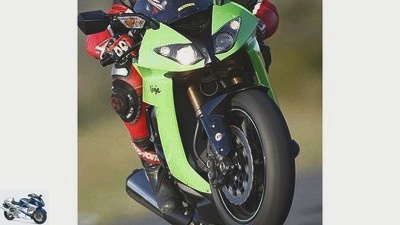
K
Wild Thing: the Kawasaki ZX-10R did not disappoint its fans.
A mighty superbike swingarm, slit eyes, corners and edges wherever you look. Just looking at the bright green ZX-10R you can tell that it means business. It does not value son-in-law manners, but presents itself as a tough men’s bike with a lot of character.
Correspondingly, the power development: Although the tachometer signals the green light at 6000 rpm, the big Kawa behaves comparatively cautiously up to around 9000 rpm, only to open the gates wide in the five-digit range and chase 182 horses out of the box. This sharp characteristic is particularly annoying at corner exit, where the thousands, instead of showing massive midrange muscles, are maximally tired ?? Moooooop ?? power. Ninja?
Well … On the brakes, the green brings back the lost meters: great to dose, with a full bite and extremely stable, it can be mercilessly compressed in front of the chicane at the end of the start / finish without twitching the rear wheel. No comparison with the brakes on the nervous Honda. Entering the corner, knees out, pulling the handlebars and ?? uff, that wasn’t so difficult last time? Only with a little effort did the test tens fight their way through the tight winding curves and force wide lines on the pilot. A feature that did not appear in previous test models and may be related to the Dunlop test tires, which do not really harmonize with the Kawa. In the country road test, the number ten on the standard Pirelli Diablo Corsa III waved through the curves as lightly as Honda’s Fireblade.
When you accelerate at the exit of a curve, the world is all right again. The shock absorber braces itself tightly but sensitively against the dynamic wheel load distribution, the fork sensitively cushions the few bumps on the test track in the south of France. This also convinces the professional racing driver Arne Tode, only when the tough drifting out of the corners does the fast Saxon want a little more feedback from the rear of the Greens. On the other hand, there is nothing wrong with the Ohlins steering damper. When the character Kawa starts to jump, it uses gentle force to ensure calm at the front. You don’t have to overdo it with being a rebel.
Conclusion

K
Who will win the race and keep the pretty nose at the front?
The Ducati 1098R wins the race, despite all obstinate electronics. One point, 24 hundredths and 21,240 euros behind that, the 2008 Honda Fireblade underpins its claim to be not only the most popular but also the best sports motorcycle in the 1000 class. The proven Yamaha YZF-R1 scored bronze, ahead of the much-anticipated KTM 1190 RC8; Rank 4 for a first serve in this strong field is impressive in any case. The other new Japanese giant, the Kawasaki ZX-10R, is pretty much the boisterous bull that its fans want. In terms of the sum of its qualities, however, it has to be ranked 7th; the facelifted warriors Suzuki GSX-R 750 and Yamaha YZF-R6 steal the show from her. Behind the ZX-10 there is a bit of air in terms of points, only then do the balanced Suzuki GSX-R 600 and, again with some distance, the BMW HP2 Sport appear in view. The Suzuki is simply not consistent enough for a racer, but drives the cuddle course; Although the BMW is radically structured, it bears heavily on its historic burden on the racetrack: the boxer engine.
Measurements
Colorful and wavy like Spaghetti Primavera, the power and torque curves meander through the diagram. The large-capacity Ducati 1098R hovers solitary above all others. Only the large-volume BMW HP2 Sport and KTM 1190 RC8 keep up to about 7000 rpm. Then the Duc shows what power output is possible without the scourge of exhaust gas and noise limits ?? it roars through an open racing exhaust. One floor below the displacement, the GSX-R 1000 and Fireblade compete. Up to 5500 rpm, the Suzuki is usually in front, from then on the Fireblade powers away. Kawasaki’s ZX-10R and especially the Yamaha R1 can’t quite keep up with them. The latter breaks in at medium speeds and also loses a bit of connection in the peak performance. But it feels much more powerful around the top than it is. In the golden mean runs the homogeneous performance curve of the GSX-R 750 ?? it makes a great compromise between performance and controllability. The curve of the smallest GSX-R is also very linear, it has significantly more pressure in the middle of the speed than the R6. It only really starts at 12,000 rpm.
Technical data and setup
Ducati 1098 R.
drive
Two-cylinder V-engine, 132 kW (180 PS) at 9750 / min *, 134 Nm at 7750 / min *, 1198 cm³, bore / stroke: 106.0 / 67.9 mm, compression ratio: 12.8: 1, Ignition / injection system, 64 mm throttle valves, hydraulically operated multi-plate anti-hopping dry clutch, six-speed gearbox, G-Kat
chassis
Steel tubular space frame, steering head angle: 65.5 degrees, caster: 104 mm, wheelbase: 1430 mm. Ø fork inner tube: 43 mm, adjustable in spring base rebound and compression. Central spring strut with deflection, adjustable in spring base, rebound and compression stage. 320 mm double disc brake with four-piston fixed calipers. 190.5 kg with a full tank, v./h .: 52.6 / 47.4%
Rear wheel power in last gear: 123 kW (167 PS) at 272 km / h
Price: 35,000 euros (incl. Ancillary costs)
Set up
fork
Rebound stage: 6 cl
Pressure level low: 4 cl
Pressure level high: –
Standard spring base
Shock absorber
Rebound stage: 13 cl
Pressure level low 12 cl
Pressure level high: –
Standard spring base
KTM 1190 RC8
drive
Two-cylinder V-engine, 114 kW (155 PS) at 9500 min, 120 Nm at 8000 / min *, 1150 cm³, bore / stroke: 103.0 / 69.0 mm, compression ratio: 12.5: 1, ignition / Injection system, 52 mm throttle valves, hydraulically operated multi-disc oil bath clutch, six-speed gearbox, G-Kat
chassis
Steel tubular frame, steering head angle: 66.7 degrees, caster: 92 mm, wheelbase: 1430 mm. Ø fork inner tube: 43 mm, adjustable in spring base rebound and compression. Central spring strut with deflection, adjustable in spring base, rebound and compression stage. 320 mm double disc brakes with four-piston fixed calipers at the front. 201 kg with a full tank, v./h .: 52.2 / 47.8%
Rear wheel power in last gear:
105.5 kW (143 hp) at 247 km / h
Price: 15,995 euros (plus ancillary costs)
Set up
fork
Rebound stage: 4 cl
Pressure level low: 1 cl
Pressure level high: ??
Standard spring base
Shock absorber
Rebound stage: 9 cl
Pressure level low: 8 cl
Pressure level high: 2 U
Spring base standard -4U
BMW HP2 Sport
drive
Two-cylinder boxer, 98 kW (133 hp) at 8750 rpm *, 115 Nm at 6000 rpm *, 1170 cm³, bore / stroke: 101.0 / 73.0 mm, compression ratio: 12.5: 1 , Ignition / injection system, 52 mm throttle valves, hydr. actuated single-plate dry clutch, six-speed transmission, G-Kat
chassis
Load-bearing engine-gearbox assembly with tubular steel subframe and self-supporting carbon rear, steering head angle: 66 degrees, caster: 86 mm, wheelbase: 1487 mm. Inner fork tube: 41 mm, adjustable in spring base, rebound and compression. Central spring strut with deflection, adjustable in spring base, rebound and compression stage. 320 mm double disc brakes with four-piston fixed calipers at the front. 206 kg with a full tank, v./h .: 52.1 / 47.9%
Rear wheel power in last gear:
91.6 kW (125 PS) at 247 km / h
Price: 21,600 euros (plus ancillary costs)
Set up
fork
Rebound stage: 6 cl
Pressure level low: 12 Kl
Pressure level high: ??
Standard spring base
Shock absorber
Rebound stage: 20 cl
Pressure level low: 6 Kl
Pressure level high: –
Standard spring base
Suzuki GSX-R 750
drive
Four-cylinder in-line engine, 110.3 kW (150 PS) at 13200 / min *, 86 Nm at 11200 / min *, 750 cm³, bore / stroke: 70.0 / 48.7 mm, compression ratio: 12.5: 1, Ignition / injection system, 42 mm throttle valves, mechanically operated multi-disc anti-hopping oil bath clutch, six-speed gearbox, G-Kat
chassis
Light alloy bridge frame, steering head angle: 66.3 degrees, caster: 97 mm, wheelbase: 1400 mm. Ø inner fork tube: 41 mm, adjustable in spring base rebound and compression. Central spring strut with deflection, adjustable in spring base, rebound and compression stage. 310 mm double disc brakes with four-piston fixed calipers at the front. 202 kg with a full tank, v./h .: 52.0 / 48.0%
Rear wheel power in last gear:
94.8 kW (129 PS) at 264 km / h
Price: 11590 Euro (plus additional costs)
Set up
fork
Rebound: 0.75 U
Pressure level low: 1.5 U
Pressure level high: 2 U
Standard spring base
Shock absorber
Rebound: 2.5 U
Pressure level low: 1 U
Pressure level high: 2 U
Standard spring base
Setup Suzuki GSX-R 600
fork
Rebound: 0.75 U
Pressure level low: 1.5 U
Pressure level high: ??
Standard spring base
Shock absorber
Rebound: 0.5 U
Pressure level low: 0.5 U
Pressure level high: 1.5 U
Spring base standard: Spring base stand: +2 U
Honda Fireblade
drive
Four-cylinder in-line engine, 131 kW (178 PS) at 12000 / min *, 112 Nm at 8500 / min *, 1000 cm³, bore / stroke: 76.0 / 55.1 mm, compression ratio: 12.3: 1, ignition / Injection system, 46 mm throttle valves, mechanically operated multi-disc anti-hopping oil bath clutch, six-speed gearbox, G-Kat
chassis
Light alloy bridge frame, steering head angle: 66.8 degrees, caster: 96 mm, wheelbase: 1410 mm. Inner fork tube diameter: 43 mm, central spring strut with deflection. 320 mm double disc brakes with four-piston fixed calipers at the front. 200 kg with a full tank, v./h .: 52.5 / 47.5%
Rear wheel power in last gear:
123.8 kW (168 PS) at 259 km / h
Price: 13760 Euro (plus additional costs)
Set up
fork
Rebound stage: 1 class
Pressure level low: 2 cl
Pressure level high: –
Standard spring base
Shock absorber
Rebound: 2 U
Pressure level low: 0.5 U
Pressure level high: ??
Standard spring base
Yamaha YZF-R1
Drive:
Four-cylinder in-line engine, 132.4 kW (180 PS) at 12500 / min *, 113 Nm at 10500 / min *, 998 cm³, bore / stroke: 77.0 / 53.6 mm, compression ratio: 12.7: 1, Ignition / injection system, 42 mm throttle valves, mechanically operated multi-disc anti-hopping oil bath clutch, six-speed gearbox, G-Kat
chassis
Light alloy bridge frame, steering head angle: 66.0 degrees, caster: 102 mm, wheelbase: 1415 mm. Inner fork tube diameter: 43 mm, central spring strut with deflection. 310 mm double disc brakes with four-piston fixed calipers at the front. 210 kg with a full tank, v./h .: 50.7 / 49.3%
Rear wheel power in last gear:
119.0 kW (163 hp) at 276 km / h
Price: 13782 Euro (plus utilities)
Set up
fork
Rebound stage: 20 cl
Pressure level low: 9 Kl
Pressure level high: ??
Standard spring base
Shock absorber
Rebound: 8 cl
Pressure level low: 5 cl
Pressure level high: 1.5 U
Standard spring base
Setup Yamaha YZF-R6
fork
Rebound stage: 15 cl
Pressure level low: 6 Kl
Pressure level high: 2 U
Standard spring base
Shock absorber
Rebound stage: 2 cl
Pressure level low: 7 Kl
Pressure level high: 2 U
Standard spring base
Suzuki GSX-R 1000
drive
Four-cylinder in-line engine, 136 kW (185 PS) at 12000 / min *, 117 Nm at 10000 / min *, 999 cm³, bore / stroke: 73.4 / 59.0 mm, compression ratio: 12.5: 1, ignition / Injection system, 44 mm throttle valves, hydraulically operated multi-disc anti-hopping oil bath clutch, six-speed gearbox, G-Kat
chassis
Light alloy bridge frame, steering head angle: 66.2 degrees, caster: 98 mm, wheelbase: 1415 mm. Inner fork tube diameter: 43 mm, central spring strut with deflection. 310 mm double disc brakes with four-piston fixed calipers at the front. 212 kg with a full tank, v./h .: 50.7 / 49.3%
Rear wheel power in last gear:
123.0 kW (168 PS) at 267 km / h
Price: 13490 Euro (plus ancillary costs)
Set up
fork
Rebound stage: 5 cl
Pressure level low: 10 Kl
Pressure level high: 2.75 U
Standard spring base
Shock absorber
Rebound stage: 4 cl
Pressure level low: 6 Kl
Pressure level high: 3 U
Standard spring base
Kawasaki ZX-10R
drive
Four-cylinder in-line engine, 138 kW (188 hp) at 12500 rpm *, 113 Nm at 8700 rpm *, 998 cm³, bore / stroke: 76.0 / 55.0 mm, compression ratio: 12.9: 1, ignition / Injection system, 43 mm throttle valves, mechanically operated multi-disc anti-hopping oil bath clutch, six-speed gearbox, G-Kat
chassis
Light alloy bridge frame, steering head angle: 64.5 degrees, caster: 110 mm, wheelbase: 1415 mm. Inner fork tube diameter: 43 mm, central spring strut with deflection. 310 mm double disc brakes with four-piston fixed calipers at the front. 208 kg with a full tank, v./h .: 50.7 / 49.3%
Rear wheel power in last gear:
124 kW (169 PS) at 275 km / h
Price: 13545 Euro (plus ancillary costs)
Set up
fork
Rebound stage: 9 cl
Pressure level low: 7 Kl
Pressure level high: ??
Standard spring base
Shock absorber
Rebound: 0.5 U
Pressure level low: 1 U
Pressure level high: 3.5 U
Standard spring base
valuation
BMW HP2 Sport
Drive: ***
The boxer vibrates pronounced and, with its overall width, hinders the sharp bending. The usable performance window is very narrow for a 1200 rpm at 2000 rpm.
Landing gear: ****
Cardan and Telelever require a lot of getting used to and a lot of training time. On the other hand, the HP2 is the most stable bike on the brakes, and its clutch dosage is fantastic.
Driving fun: ******
Love her or hate her. Anyone who gets involved with the BMW can have a lot of fun with it, but will never come close to the lap times of the Japanese standard diet.
Lap time: * 1: 29.33 min
PS judgment: 14 points, 9th place
The best boxer BMW ever. Nevertheless, the HP2 is only enough for the red lantern. The conceptual disadvantages of the air-cooled boxer are too great.
Ducati 1098 R.
Drive: *********
A hammer, this V2. Pushes, pushes and burns in all situations, is wild and tamed at the same time. Hardly any vibrations and good manners are convincing.
Landing gear: *********
A stable chassis, sensitive spring elements and large setting ranges are essential for successful time ignition. The 1098R has it on board as standard and classy.
Driving fun: **********
The 1098R inspires with its crazy engine. If that’s not enough for you, you just have to bend back violently to desire it. And that great, unfortunately illegal, sound…
Lap time: ********** 1: 26.04 min
PS judgment: 38 points, 1st place
Despite the electronics defect, the reference motorcycle is the fastest. That proves how well the package of the 1098R works even without DTC. respect!
Honda Fireblade
Drive: **********
The Honda shows the competition how to do it. Above all, their brutal pulling power and the linear power delivery ensure happy faces.
Landing gear: *********
The fantastic handling and the great suspension elements give the Honda plenty of points. The restless tail when braking hard gives slight deductions.
Driving fun: *********
The brake is not up to the race track load and is annoying with a shifting pressure point. The engine and driving behavior are great fun.
Lap time: ********* 1: 26.28 min
PS judgment: 37 points, 2nd place
The Fireblade outperforms the competition. Only Ducatis 1098R pushes the red nose a little earlier over the target line. But it also costs over 20,000 euros more.
Kawasaki ZX-10R
Drive: ******
Despite 182 hp, the ZX-10R only lands in the middle of the field. The top performance and the poor pulling force push the tens to about the level of the Suzuki GSX-R 750.
Landing gear: ******
The fork and shock absorber respond cleanly and also have sufficient damping on the racetrack. The sluggish handling of the test Kawa costs points.
Driving fun: ******
Despite the great brakes, the Kawa is only moderately fun on the racetrack. The high performance of the engine is annoying when accelerating out of corners.
Lap time: ******* 1: 26.97 min
PS judgment: 25 points, 7th place
With its excellent performance and the not very agile handling, the ZX-10R cannot quite keep up with the other 1000s. She shines with a lot of character.
KTM 1190 RC8
Drive: *****
It has great performance, but a gruesome response. The smoothness and the gear actuation cannot convince. Fine-tuning, but immediately!
Landing gear: ********
The test RC8 can set accents, but not dominate. She is agile, a corner chaser and gives good feedback, unfortunately she understeers a bit.
Driving fun: *******
Whether it’s a country road or a racetrack, the RC8 always turns on and can do both very well. A heavy hindering fun is the very hard response of the twin.
Lap time: ********* 1: 26.49 min
PS judgment: 29 points, 4th place
The RC8 needs another year of tire. Once the response has been cured and the gearbox is a little more precise, things will get tight for the competition.
Suzuki GSX-R 600
Drive: ****
Controllable, supple, uncomplicated ?? or just plain, boring, bloodless. For someone who wants to be an athlete, this 600 engine clearly has too little bite.
Landing gear: ******
?? She can be conducted ?? hits the nail on the head: the little Gixxer does a lot in the meandering and shines with stability, but she is not an ultra-sharp, self-thinking curve file.
Driving fun: ******
If you don’t need the ultimate kick of the last hundredth of a second, but just want to be on the move quickly, you will have fun with the GSX-R 600.
Lap time: **** 1: 28.33 min
PS judgment: 20 points, 8th place
God knows not a bad motorcycle, an inexpensive one too, but can only dance carefully after the dance of the over-hammers.
Suzuki GSX-R 750
Drive: ******
A bit rough with the load changes, without the elemental force of the 1000, but with significantly more pressure than its little sister, the 750 engine scores in the middle.
Landing gear: ******
You have to work with the chassis. The GSX-R is long and, in terms of ergonomics, a bit off the ideal racetrack line; the driver slips around uncontrollably.
Driving fun: ********
Yes, the Dreiviertelgixxer is more fun than the bigger one and more fun than the smaller sister: It combines sufficient pressure with stress-free manners and predictability.
Lap time: ******** 1: 26.92 min
PS judgment: 28 points, 5th place
“atsch”, you hear them say in the direction of the ZX-10R: Balance beats elemental strength in lap times; Even as a complete package, the GSX-R 750 is the better and, last but not least, the cheaper choice.
Suzuki GSX-R 1000
Drive: ********
The engine bursts with power at every speed, runs very cultivated and convinces with a smooth throttle response and an excellent shiftable gearbox.
Landing gear: *******
The Suzi circles arches very neutrally. The feel for the front could be more transparent, the spring elements work well and inconspicuously.
Driving fun: *******
The big plus of the Kilo-Gixxer is their homogeneity and their simplicity. A pleasant everyday buddy with a fantastic engine.
Lap time: – (no evaluation, as cold-formed)
PS judgment: (no evaluation, as cold-formed)
The GSX-R 1000 would have landed at least in the front midfield. However, due to the lack of lap time, PS has to owe the proof.
Yamaha YZF-R6
Drive: *****
The old story: The R6 can handle speeds, but needs them like no other. If you don’t squeeze the engine constantly, you can hardly move.
Landing gear: ********
The 600 cliche is also fulfilled here: The R6 is handy, precise and razor-sharp. Biggest drawback: Does not get along well with your first tires.
Driving fun: ********
If you order racing, you shouldn’t complain if you also get racing. In its purest form. Only the brake was quite weak this time.
Lap time: ****** 1: 27.49 min
PS judgment: 27 points, 6th place
With its lap time, the R6 is closer to the slowest 1000cc than to its displacement colleague Suzuki GSX-R 600. Whoever has driven it is hardly surprised.
Yamaha YZF-R1
Drive: *******
Yes, yes, the performance of the R1: Often tested and criticized. After the slight sag at medium speeds, the yam tears irresistibly.
Landing gear: ********
Class spring elements. They respond sensitively and have decent damping reserves. The handling is amazing, the brakes bite hard.
Driving fun: ********
The Yamaha R1 challenges its rider, always wants their attention and concentration. If you take that into account, the Yamaha is in a great mood.
Lap time: ******** 1: 26.75 min
PS judgment: 31 points, 3rd place
Only the Duc and the Fireblade are ahead of the R1. Considering the fact that the yam hit the market over a year ago, a great result.
Dunlop GP Racer Slick
According to Dunlop, the GP Racer Slick is a slick for hobby drivers. In other words, a tire that offers slick-like grip and, of course, the profile-less look, but does without the typical peculiarities of racing skins. In other words, the GP Racer warms up quickly and offers grip, but makes the chassis tuning, which is otherwise essential for racing tires, superfluous. The slipper is available in two mixtures, the front in ?? S ?? (Soft) and ?? M ?? (Medium), in the back in ?? M ?? and ?? E ?? (Endurance). The rear tire has a two-component tread with softer sidewalls and a harder center, while the front tire uses a mixture.
PS is impressed by the GP racer Slick, at the front ?? M ??, at the rear ?? E ??: the tire actually heats up quickly, and it was already possible to accelerate vigorously at the end of the second lap (without tire warmers). The border area of the stiff, low self-damping tire sets in good-naturedly and is therefore easy to locate. However, the rear wheel tends to overheat under a professional like Arne Tode. The IDM champ brought the rubber temperature of the rear wheel of the KTM RC8 to over 100 degrees. A hobby racer should not be able to do this. Good news at the end: The GP-Racer Slick is available for the price of a profiled supersport tire.
Polo tire warmers
In order to bring the Dunlop slicks to the correct operating temperature before the lap times classification, PS resorted to tire warmers from Polo. The heating pods, which cost 249 euros, did their job unobtrusively and heated the rubbers to 70 degrees Celsius on the front wheel and 65 ° C on the rear wheel within 30 minutes when there was no wind and an air temperature of around 15 degrees. After 45 minutes at the latest, the promised and thermostatically controlled 75 ° C were reached.
Related articles
-
Comparison test: Japanese naked bikes
Jahn motorcycles Comparison test: Japanese naked bikes Comparison test: Japanese naked bikes Go big Content of …or go home! Big bore instead of boring,…
-
Comparison test: BMW R 1200 GS, Ducati Hypermotard 1100 S, KTM 990 Supermoto
Jahn motorcycles Comparison test: BMW R 1200 GS, Ducati Hypermotard 1100 S, KTM 990 Supermoto Comparison test: BMW R 1200 GS, Ducati Hypermotard 1100 S,…
-
Comparison test: large naked bikes
K motorcycles Comparison test: large naked bikes Comparison test: Large naked bikes, Ducati Monster S4, Kawasaki Z 1000, KTM 990 Super Duke R, Triumph…
-
Comparison test: 600cc extreme athlete
K motorcycles Comparison test: 600cc extreme athlete Comparison test: 600cc extreme athlete Spear tips Content of They flaunt long lances at the end, are…
-
Comparison test: Honda Hornet, Kawasaki Z 750, Suzuki GSR 600
Jahn motorcycles Comparison test: Honda Hornet, Kawasaki Z 750, Suzuki GSR 600 Comparison test: Honda Hornet, Kawasaki Z 750, Suzuki GSR 600 ABS shooters…
-
Comparison test: Supersport 600 series
motorcycles Comparison test: Supersport 600 series Comparison test: Supersport 600 series Screeching traffic Content of They scream their hearts out,…
-
Bilski motorcycles Comparison test: KTM 990 Super Duke, Moto Morini Corsaro 1200 Veloce, Triumph Speed Triple, Yamaha FZ1 Comparison test: KTM 990…
-
fact motorcycles Comparison test: Honda CBR 600 RR, Kawasaki ZX-6R, Suzuki GSX-R 600, Triumph Daytona 675, Yamaha YZF-R6 Comparison test: Honda CBR 600…
-
Comparison test: Suzuki Hayabusa old against new
motorcycles Comparison test: Suzuki Hayabusa old against new Comparison test: Suzuki Hayabusa old against new Shoot out boys! Content of Hayabusa, the…
-
Comparison test: 600s in a quintet
Jahn motorcycles Comparison test: 600s in a quintet Comparison test: 600s in a quintet Toys Content of The middle class is burning brightly! The…